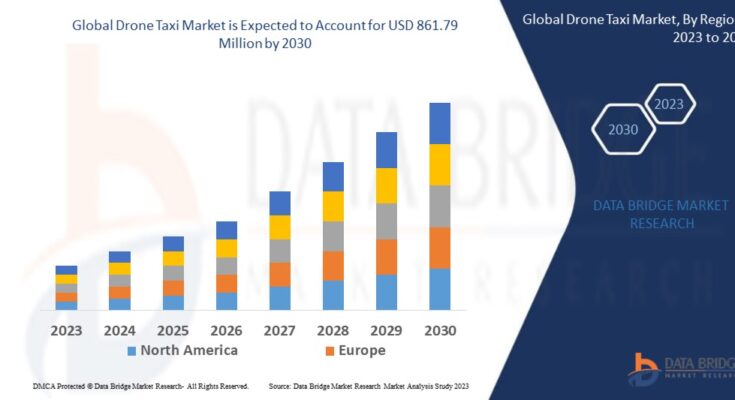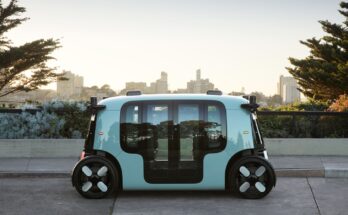i The concept of drone taxis, also known as autonomous air taxis or flying cars, has been gaining significant attention in recent years as a potential solution to urban traffic congestion and transportation challenges. A drone taxi is essentially an unmanned aerial vehicle (UAV) that is designed to carry passengers from one location to another autonomously, without the need for a human pilot.
The drone taxi market is still in its early stages, with a few companies currently developing and testing prototype vehicles. Some of the companies that are leading the way in this field include Uber Elevate, Volocopter, EHang, Lilium, and Airbus. These companies are working on developing drone taxi systems that can safely transport passengers in urban environments, with the goal of making air transportation accessible to more people.
The benefits of drone taxis are numerous. They could potentially reduce traffic congestion, provide faster and more efficient transportation, and reduce carbon emissions from traditional ground transportation. Additionally, they could improve access to remote or hard-to-reach areas and provide new transportation options for people with limited mobility.
However, there are also challenges that need to be addressed before drone taxis can become a viable transportation option. These include issues related to safety, regulatory frameworks, and public acceptance. Nevertheless, the drone taxi market is expected to grow significantly in the coming years, with some estimates projecting the market to reach a value of several billion dollars by 2030.
Drone taxi overview
Drone taxis, also known as flying taxis, are an emerging transportation technology that is designed to offer a new mode of urban transportation. The concept of drone taxis has been around for several years, but it is only recently that the technology has started to become a reality.
The idea of a flying taxi can be traced back to the early 20th century when inventors and futurists started to envision a world where people could travel through the air in small, personal aircraft. However, it wasn’t until the 21st century that the concept of a drone taxi really started to take off.
In 2016, Uber announced that it was developing a fleet of flying taxis to be launched in Dubai by 2020. The taxis, which were to be electric vertical takeoff and landing (eVTOL) aircraft, were part of a partnership with the Dubai Road and Transport Authority. However, the project was delayed due to regulatory and logistical challenges, and as of 2021, there is no word on when it will be launched.
Other companies, such as German start-up Volocopter, have also been working on developing drone taxis. In 2019, Volocopter successfully completed a test flight of its eVTOL aircraft in Singapore. The company has also conducted tests in Germany and Dubai, and it is working towards launching commercial services in the near future.
Chinese company EHang is another player in the drone taxi market. In 2019, EHang launched a pilot program for its autonomous passenger drones in Vienna, Austria. The company has also conducted successful test flights in China and Dubai.
In summary, the concept of drone taxis has been around for decades, but it is only recently that the technology has started to become a reality. Companies such as Uber, Volocopter, and EHang have been working on developing eVTOL aircraft for commercial use, and while there have been delays and challenges, progress is being made towards launching drone taxi services in the near future.
Benefits of drone taxis
- Faster travel: Drone taxis can travel faster than traditional ground-based transportation methods such as cars, buses, and trains. They can fly directly from one point to another, bypassing traffic congestion and reducing travel time.
- Reduced traffic congestion: By taking to the skies, drone taxis can reduce traffic congestion on the ground, which can help to alleviate air pollution and reduce travel times for other forms of transportation.
- Improved safety: Drone taxis can design with safety features such as automatic obstacle avoidance systems. Which can reduce the risk of accidents and improve safety for passengers.
- Increased accessibility: Drone taxis can make transportation more accessible to people in areas with poor infrastructure. Limited access to ground-based transportation.
- Cost-effective: Over time, drone taxis may become more cost-effective than traditional ground-based transportation methods. Which require less infrastructure and can operate remotely, reducing labor costs.
- Improved emergency response: In emergency situations, drone taxis can use to transport medical supplies, emergency responders, or injured individuals quickly and efficiently.
Overall, drone taxis have the potential to offer a faster, safer, more accessible. And cost-effective form of transportation for people in urban areas. However, there are also potential challenges that need to be address, such as regulatory hurdles, technological limitations, and public acceptance.
Market size of drone taxi market
- According to data from Data Bridge Market Research, the drone taxi market is anticipate to grow at a CAGR of 63.000% from 2022 to 2030. USD 17.29 million to USD 861.79 million.
- The market report created by the Data Bridge Market Research team includes in-depth expert analysis. Which import/export analysis, pricing analysis, production consumption analysis. And pestle analysis in addition to market insights like market value, growth rate, market segments, geographical coverage, market players, and market scenario.
- The demand for a better and more efficient transportation system has grown. As a result of the rising number of vehicles on the road. The lucrative rise in traffic congestion in urban areas, which has increased demand for the drone taxi globally.
- Additionally, the “fully electric” propulsion segment is anticipate to experience. The fastest growth during the forecast period due to rising demand for low emission. High performance, and fuel-efficient cars that have better endurance than other propulsion systems. And enable drone taxis to fly for longer periods of time.
Driving factors of drone taxis market
-
A rise in the demand for ambulance drones in the healthcare industry
Throughout the predicted period, the hospital and medical category experienced strong growth. Due to their multiple benefits, such as their ability to bypass transportation obstacles like traffic jams and closed roads. And their ability to travel more quickly and efficiently through challenging terrain like mountains, ambulance drones are in higher demand in hospitals. For speedier ambulatory care at events like festivals and fairs, ambulance drones are especially useful. Also, traditional ambulances are expensive and need human drivers, medical professionals, and technicians. But ambulance drones are much less expensive and need much less personnel to run.
-
Intracity range-based drone taxis are very popular.
The main range segment with significant increase during the projection period is intracity. Its significant market share can be attributable. The significant demand for air travel in the central urban districts and in the affluent suburbs around the metropolis. Leading manufacturers are already making investments in the creation of effective and cutting-edge intercity transportation services. Which ncluding Lift, Airbus, Volocopter, and Boeing, among others. As an e-VTOL jet with a cruising speed of more than 300 km/hr, the Lilium Jet is one such example. The corporation is organizing this plane primarily for intracity travel before moving on to intercity travel.
About Us
The most complete offering of market research services and products on the internet is provided by Data Bridge Market Research. We provide reports from almost all major magazines and continually update our list to give you rapid online access to the largest. And most current collection of expert views about international markets, businesses, items, and patterns.
A pioneer in cutting-edge formative research is Data Bridge Market Research. We take pride in providing data and analysis that match and suit the goals of our existing and potential customers.



